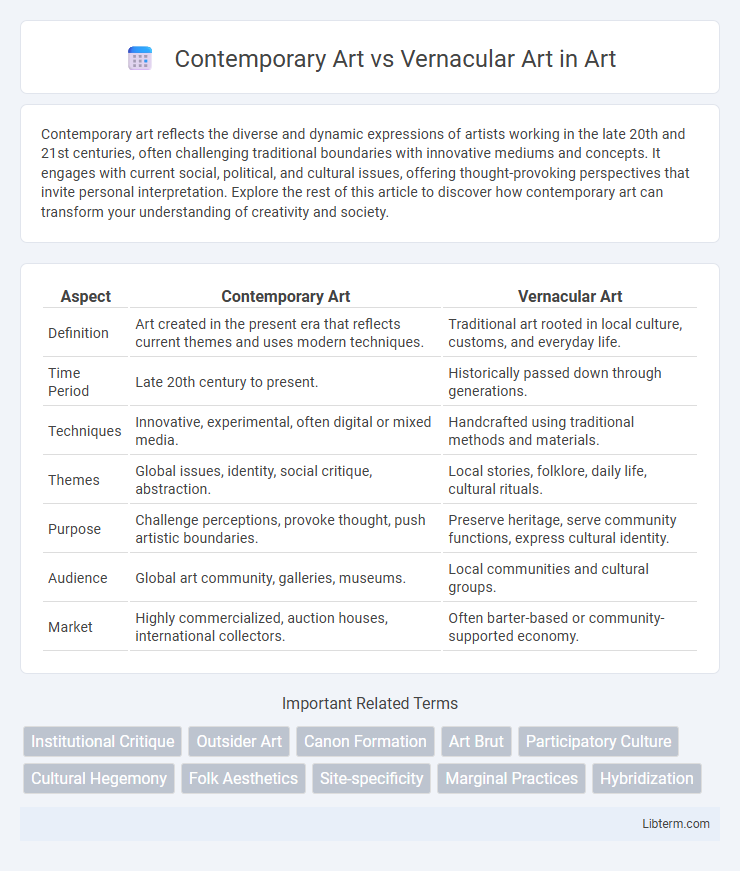Contemporary art reflects the diverse and dynamic expressions of artists working in the late 20th and 21st centuries, often challenging traditional boundaries with innovative mediums and concepts. It engages with current social, political, and cultural issues, offering thought-provoking perspectives that invite personal interpretation. Explore the rest of this article to discover how contemporary art can transform your understanding of creativity and society.
Table of Comparison
| Aspect | Contemporary Art | Vernacular Art |
|---|---|---|
| Definition | Art created in the present era that reflects current themes and uses modern techniques. | Traditional art rooted in local culture, customs, and everyday life. |
| Time Period | Late 20th century to present. | Historically passed down through generations. |
| Techniques | Innovative, experimental, often digital or mixed media. | Handcrafted using traditional methods and materials. |
| Themes | Global issues, identity, social critique, abstraction. | Local stories, folklore, daily life, cultural rituals. |
| Purpose | Challenge perceptions, provoke thought, push artistic boundaries. | Preserve heritage, serve community functions, express cultural identity. |
| Audience | Global art community, galleries, museums. | Local communities and cultural groups. |
| Market | Highly commercialized, auction houses, international collectors. | Often barter-based or community-supported economy. |
Defining Contemporary Art and Vernacular Art
Contemporary art encompasses diverse, innovative works produced by living artists that reflect current cultural, social, and political contexts, often emphasizing concept, experimentation, and global influences. Vernacular art refers to traditional, folk, and community-based art forms rooted in everyday cultural practices and local life, expressing collective identity through accessible, informal media. Defining contemporary art requires understanding its fluid boundaries and engagement with modernity, while vernacular art centers on heritage, preservation, and grassroots creativity.
Historical Context and Evolution
Contemporary art emerged in the mid-20th century as a global movement reflecting current social, political, and technological changes, often challenging traditional boundaries and embracing diverse media. Vernacular art, rooted in local traditions and community practices, evolved through generations as a means of cultural expression and preservation, frequently produced by self-taught artists outside formal art institutions. The historical context of contemporary art highlights a shift towards conceptual innovation and global dialogue, whereas vernacular art emphasizes continuity, identity, and localized narratives within historical frameworks.
Core Principles and Philosophies
Contemporary art emphasizes innovation, individual expression, and the exploration of new media and concepts, often challenging traditional boundaries and reflecting current social issues. Vernacular art is rooted in local culture, community traditions, and everyday experiences, prioritizing functionality and cultural continuity over formal aesthetics. The core philosophy of contemporary art revolves around conceptual freedom and global dialogue, while vernacular art centers on cultural identity, collective memory, and the preservation of heritage.
Artistic Techniques and Materials
Contemporary art employs a diverse range of innovative techniques and materials, including digital media, installation, and mixed media, often pushing the boundaries of traditional art forms. Vernacular art relies on locally sourced, natural materials such as wood, clay, and textiles, with techniques passed down through generations, emphasizing cultural heritage and craftsmanship. The contrast highlights how contemporary artists embrace experimentation and technology, while vernacular artists prioritize tradition and community-based methods.
Cultural Influences and Identity
Contemporary art reflects global cultural influences, often blending diverse traditions to challenge or redefine identity in a rapidly changing world. Vernacular art, rooted in local customs and community practices, preserves unique cultural narratives and collective memory through traditional techniques and motifs. Both forms embody identity, yet contemporary art interrogates hybridity and globalization, while vernacular art emphasizes heritage and continuity.
Audience Engagement and Reception
Contemporary art often engages audiences through conceptual depth and innovative use of materials, attracting viewers who seek intellectual stimulation and critical interpretation. Vernacular art resonates with local communities by reflecting cultural traditions, everyday life, and accessible symbolism, fostering a more intimate and immediate emotional connection. Audience reception varies widely, with contemporary art challenging perceptions and encouraging dialogue, while vernacular art promotes cultural identity and shared heritage appreciation.
Representation in Museums and Galleries
Contemporary art is prominently showcased in major museums and galleries worldwide, often emphasizing innovative concepts and current cultural dialogues. Vernacular art, rooted in local traditions and everyday life, struggles for visibility in mainstream institutions but gains recognition through ethnographic museums and community exhibitions. Representation disparities highlight the ongoing debate about cultural value and institutional validation in the art world.
Impact on Local and Global Art Markets
Contemporary art drives global art markets by attracting international collectors through innovative styles and high-profile exhibitions, significantly influencing market trends and valuations. Vernacular art, rooted in local culture and traditions, strengthens community identity and sustains regional economies through niche markets and cultural tourism. The interaction between contemporary and vernacular art enriches both markets, fostering cross-cultural appreciation and expanding opportunities for diverse artistic expressions worldwide.
Challenges and Criticisms
Contemporary art faces challenges related to commercialization and elitism, often criticized for being inaccessible to general audiences and overly driven by market trends rather than cultural significance. Vernacular art, rooted in local traditions and everyday practices, struggles with issues of preservation and recognition within mainstream art discourse, frequently overlooked as "folk" rather than legitimate art forms. Both art forms encounter debates over authenticity and value, highlighting tensions between institutional validation and community-based cultural expression.
The Future of Contemporary and Vernacular Art
Contemporary art continues to evolve through digital innovation and global cultural exchanges, fostering new forms of expression that challenge traditional boundaries. Vernacular art preserves cultural identity by emphasizing local customs, materials, and storytelling, ensuring its relevance in a rapidly globalizing world. The future of both art forms lies in a dynamic dialogue where contemporary techniques amplify vernacular narratives, creating hybrid experiences that resonate across diverse audiences.
Contemporary Art Infographic

 libterm.com
libterm.com